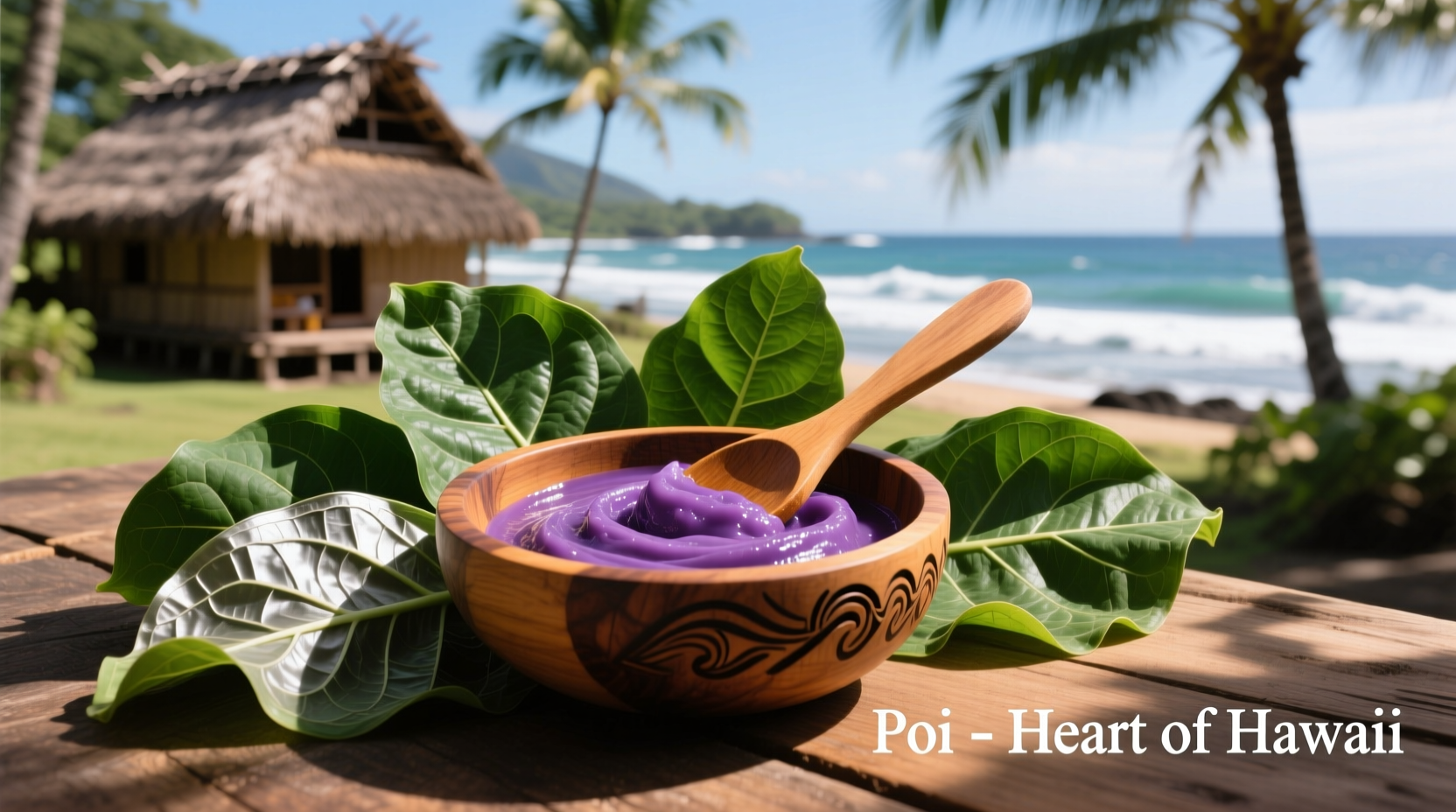Understanding Poi: Hawaii's Cultural Culinary Treasure
If you've ever attended a Hawaiian luau or explored Pacific Islander cuisine, you might have encountered poi—a distinctive food with a unique texture and cultural significance. But what exactly is poi food? Many confuse it with other dishes or misunderstand its preparation and importance. Let's explore this traditional Hawaiian staple that has sustained island communities for centuries.
What Makes Poi Unique Among Traditional Foods
Poi stands apart from other traditional starches due to its specific preparation method and cultural context. Unlike mashed potatoes or other root vegetable preparations, authentic poi begins with taro root (known as kalo in Hawaiian), which undergoes a specialized process:
- Young taro corms are harvested after 6-12 months of growth
- Roots are steamed or baked until tender
- Cooked taro is peeled and placed on a wooden board
- Using a stone pounder (pōhaku kuʻi ʻai), the taro is rhythmically pounded
- Water is gradually added during pounding to achieve desired consistency
- The final product develops a slightly sour flavor through natural fermentation
The texture ranges from thick and dough-like (one-finger poi) to thin and drinkable (three-finger poi), referring to how many fingers you'd need to stir it. This distinctive preparation method creates a food that's both nutritious and deeply meaningful to Hawaiian culture.

The Historical Journey of Poi in Hawaiian Culture
| Historical Period | Significance | Cultural Context |
|---|---|---|
| Pre-Contact Hawaii (Before 1778) | Taro was the primary staple crop | Grown in sophisticated loʻi (irrigated terraces); considered sacred |
| Early Missionary Period (1820s-1850s) | Introduction of Western foods began shifting diets | Missionaries discouraged poi consumption, calling it "primitive" |
| Territorial Period (1898-1959) | Poi production became commercialized | First poi factories established; canning technology developed |
| Modern Era (1970s-Present) | Revival of Hawaiian cultural practices | Poi recognized as culturally significant; traditional farming methods restored |
This timeline shows how poi's role evolved from being the absolute dietary foundation of Hawaiian society to facing near-elimination during Western influence, then experiencing a cultural renaissance in recent decades. According to the University of Hawaii's College of Tropical Agriculture and Human Resources, taro was so central to Hawaiian life that the Hawaiian word for food (ʻai) and the word for taro (kalo) are linguistically related.
Why Poi Matters Beyond Nutrition
Understanding what poi food represents requires looking beyond its physical composition. In Hawaiian tradition, poi carries profound cultural meaning:
- Spiritual significance: Taro is considered the elder sibling of the Hawaiian people in creation stories
- Community building: The pounding process traditionally involved multiple people working together
- Health connection: The natural fermentation creates probiotics beneficial for digestion
- Sustainability model: Taro farming systems created self-sustaining agricultural ecosystems
The cultural context of poi extends to its consumption etiquette. Traditionally, poi was never stirred clockwise (which represented negative energy), and the number of fingers used to eat it indicated its consistency and freshness. These practices reflect the deep connection between food and philosophy in Hawaiian culture.
Modern Poi: Tradition Meets Contemporary Life
Today, poi remains a vital part of Hawaiian identity while adapting to modern lifestyles. You'll find it in various forms:
- Traditional fresh poi: Made daily in homes and at cultural events
- Canned poi: Available in Asian grocery stores and online, with shelf life of 1-2 years
- Dried poi powder: Reconstituted with water for convenience
- Innovative culinary uses: Incorporated into pancakes, smoothies, and desserts
According to the Hawaii Department of Agriculture, commercial poi production has grown steadily since the 1990s as part of the broader Hawaiian cultural renaissance. However, traditionalists emphasize that fresh, handmade poi offers superior flavor and texture compared to processed versions. The natural fermentation process that gives poi its characteristic tang cannot be perfectly replicated in commercial production.
Common Misunderstandings About Poi
Several misconceptions surround poi that deserve clarification:
- Myth: Poi is made from breadfruit or other starches
- Reality: Authentic poi comes exclusively from taro root (kalo)
- Myth: Poi is always sweet
- Reality: Traditional poi develops a natural sourness through fermentation
- Myth: Poi is difficult to eat
- Reality: Many enjoy it plain, while others mix it with sugar, milk, or fruit
It's also important to distinguish Hawaiian poi from other foods with similar names. In Chinese cuisine, "poi" refers to a different preparation, and in some contexts, "poi" describes a performance art with weighted balls. Understanding these distinctions helps appreciate Hawaiian poi in its proper cultural context.
How to Experience Authentic Poi
If you're curious about trying poi, here's how to approach it authentically:
- Start with commercially available poi if fresh isn't accessible
- Chill it before serving (traditional consumption method)
- Try it plain first to appreciate its natural flavor
- Experiment with additions like sugar, coconut milk, or bananas
- Attend a Hawaiian cultural event where poi is served traditionally
For those interested in making poi at home, small taro corms are available at Asian markets. The process requires patience—the pounding stage traditionally took 30-60 minutes of rhythmic motion to achieve the proper smooth consistency without lumps. Many cultural practitioners consider the physical act of pounding poi as important as the final product, connecting modern Hawaiians to their ancestors' traditions.
Preserving a Living Tradition
The story of poi is one of cultural resilience. Despite efforts to suppress Hawaiian traditions during the territorial period, poi survived as a symbol of cultural identity. Today, organizations like the Hawaiian Mission Children's Society and the University of Hawaii's Kalo Research Program work to preserve traditional taro varieties and farming methods.
According to a 2023 survey by the Pacific American Foundation, 78% of Native Hawaiians consider poi an essential part of their cultural identity, while 62% of non-Hawaiian residents of Hawaii have tried poi and appreciate its cultural significance. This growing appreciation helps ensure that poi remains more than just food—it continues as a living connection to Hawaiian heritage.











 浙公网安备
33010002000092号
浙公网安备
33010002000092号 浙B2-20120091-4
浙B2-20120091-4